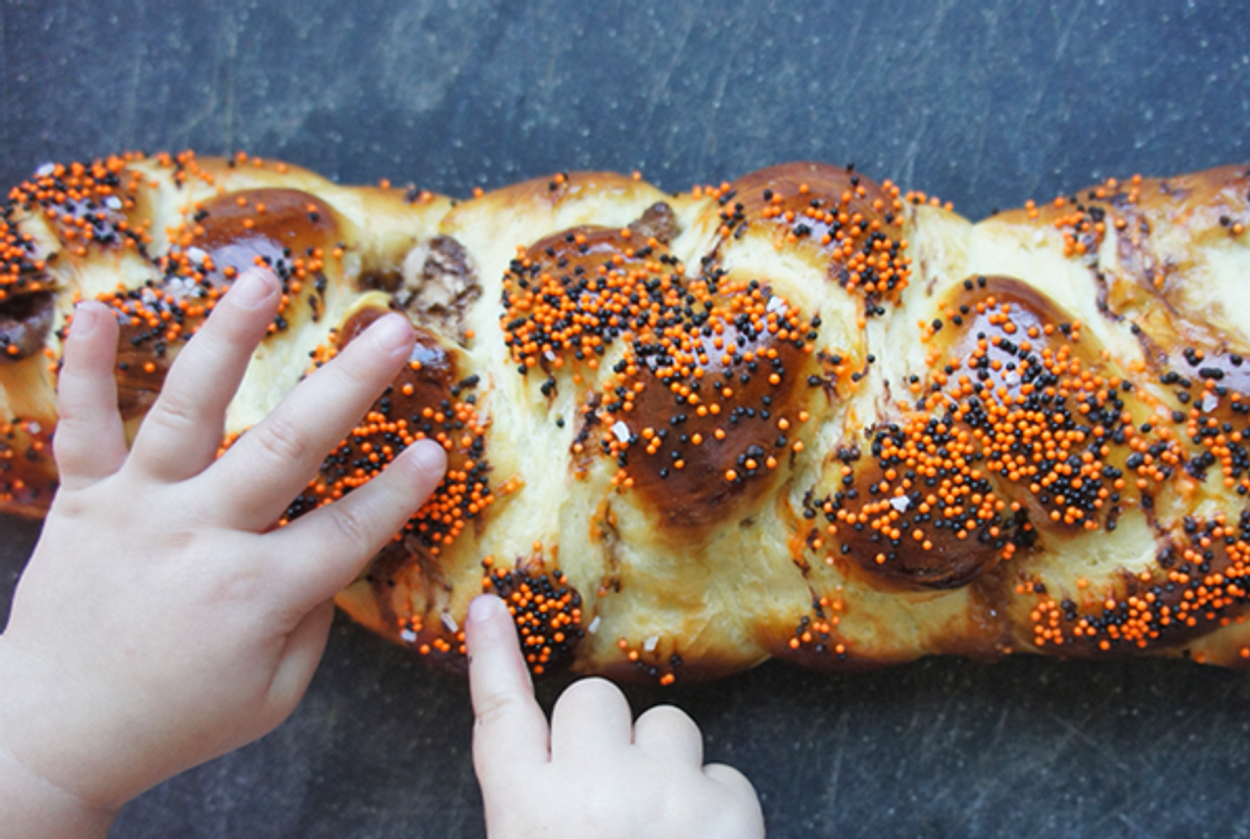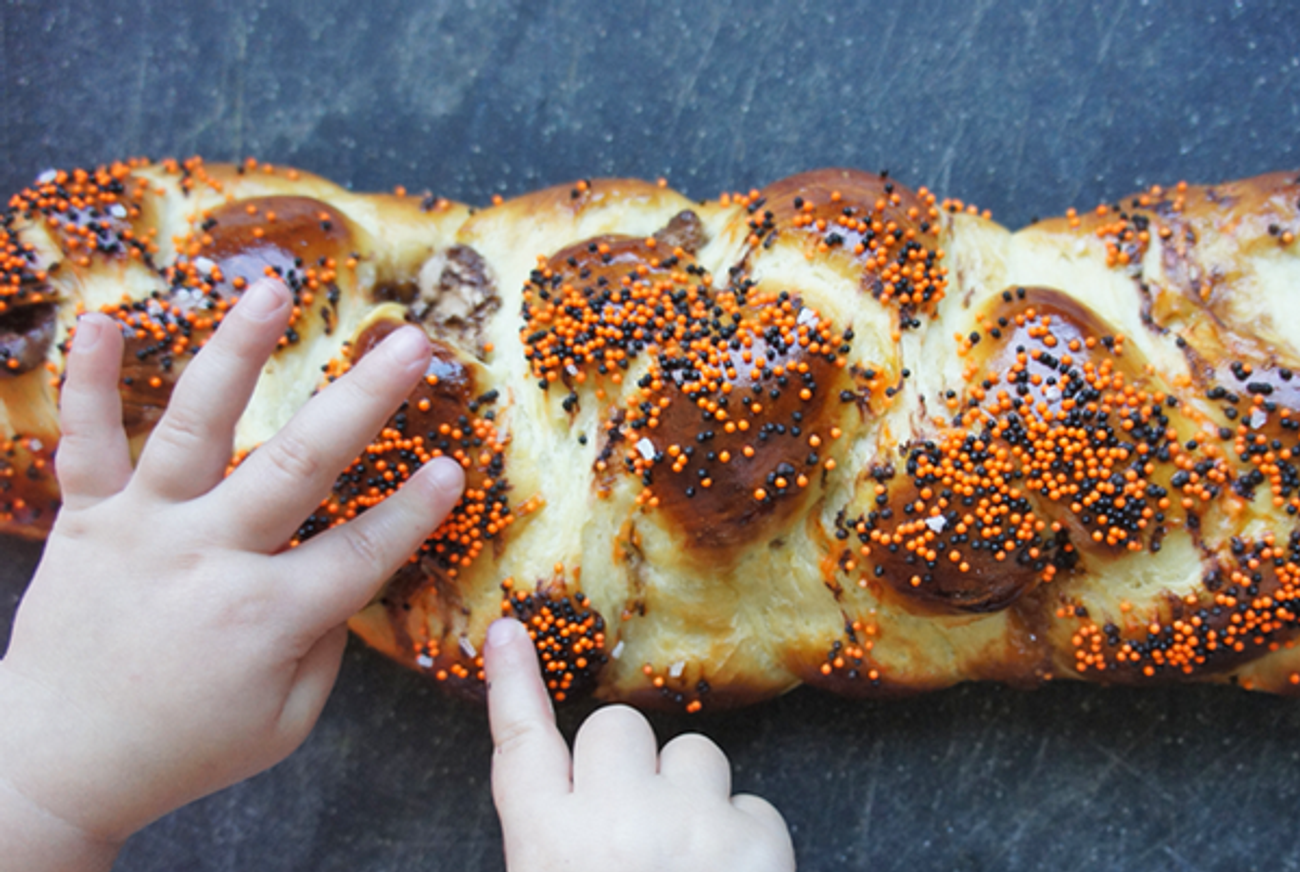A Candy-Filled Challah: No Trick, But an Amazing Treat
What do you do when Halloween falls on Shabbat? Braid together your Jewish and American traditions in a sweet loaf of bread.




Halloween this year falls on Shabbat. This is of little consequence for Jews who view Halloween as an idolatrous, pagan holiday rooted in Catholicism; they will celebrate Shabbat as they do every week and ignore Halloween as they do every year. Other Jews, meanwhile, will do the exact opposite and celebrate the bacchanalia without taking any notice of Shabbat.
The rest of us may be said to have a more complicated relationship to Halloween—and Shabbat. Some of us look forward to our Friday night rituals and also enjoy dressing up for trick-or-treat.
Many people have pointed out that Judaism already has a holiday akin to Halloween—Purim—and that this is what Jewish children should be celebrating instead of the commercial, overtly Christian “version.” But Purim and Halloween are not the same. While both holidays involve dressing up and eating sweets, Purim also has a serious side: the story of Esther and the survival of the Jewish people. Meanwhile, Halloween’s serious (and dark) side has mostly disappeared—at least for modern American Jews like me; it’s not a day for us to connect with dead relatives or cast spells, but simply a night to have fun, play make-believe, and participate in community activities.
It’s also a time to eat. And this year, with Halloween falling on Shabbat, I’m going to make one of my favorite recipes, which brings the two holidays together: Halloween candy challah.
***
As a child, I never realized there were religious connotations to Halloween. As a child of an interfaith marriage, I had experience with an array of holidays—Christian, Jewish, and secular—and Halloween seemed to fall in the “secular” category. Neither my Italian-Catholic mother nor my Jewish dad expressed any concern over its pagan and/or Christian origins.
Halloween was a magical time of year when I was growing up in upstate New York. Fall had barely begun, and my mother would deck the front of the house with spider webs, paper pumpkins, and homemade wooden gravestones. On Halloween night, as dusk set in, she would place a big boom box in one of our front windows and play a “spooky” tape on a loop; organ music, shrieks, screams, and cackles continued through the evening. With the stage set, she then put on a witch costume and readied herself for the onslaught of painted-faced, sugar-hungry tiny humans.
As a rather dramatic child, I was focused on the chance to play pretend in such an elaborate fashion. The fact that Mom was in on the fun made this accepted annual ritual of make-believe, dress-up, and candy consumption even better. I dressed as a scary witch almost every year, always wanting my mom to make me look as frightening as possible. Aside from trick-or-treating, we’d watch Halloween specials and scary movies on TV, rocking out to “Monster Mash” in our living room, and wait to see if our house would get egged or covered in toilet paper.
I still love Halloween today as an adult, living in Jersey City with my husband and our daughter. While my Jewish identity has evolved and deepened, and my knowledge expanded greatly since my childhood, I still don’t find celebrating Halloween problematic. Neither does my husband, who grew up in a Modern Orthodox family and celebrated Halloween as a young child but then stopped when he enrolled at a Jewish day school. In fact, so infectious is my enthusiasm for Halloween that my in-laws now also join in the fun with us each year, dedicating a weekend every October to pumpkin-picking and one of our favorite annual activities: the Ragamuffin parade near my in-laws’ house. For us, Halloween does not threaten our Jewishness; it is merely a part of our American-ness.
My daughter, now 2 and a half, is aware of Halloween for the first time this year. She’s excited about our costumes, marching in our local parade, and of course the candy. Every time she sees a spooky spider or eagerly points to a pumpkin decoration, I am brought back to my childhood and my mom’s festive antics, which is both welcome nostalgia and a way to connect with my mother, who is no longer alive.
There is a golden rule in improv that states all performers should respond to another’s idea with “yes, and.” If someone says, “Hey look, there’s a monster behind you!” and you say, “There’s no monster,” then the scene is dead, there’s nowhere to go. In a way, American Jews are doing our own version of improv these days. We are Jewish, living in a diverse and secular country, navigating all sorts of situations that require flexibility and open-mindedness while still maintaining a sense of pride in our past and traditions.
I want to be the kind of Jew who says “yes, and,” so I argue that we don’t have to celebrate Shabbat or Halloween. We can embrace Shabbat and Halloween. I want to be Jewish and part of the American cultural landscape. I want my children to feel they can celebrate Purim and Halloween—while appreciating their differences.
So, this Friday night, we will go out and celebrate Halloween with our community in Jersey City, relishing the costumes, treats, and new friends we will make in the process. When we are done, we will head home with our plastic pumpkins filled to the brims and share Shabbat dinner as a family. Perhaps after a meal of Halloween-candy stuffed challah (recipe here), pumpkin soup, and warm apple cider, we will crawl into bed together and watch some cartoons, balancing the tradition of Shabbat with the whimsy and fun of Halloween, together as a family.
***
Like this article? Sign up for our Daily Digest to get Tablet Magazine’s new content in your inbox each morning.
Shannon Sarna is editor of The Nosher and writes for other food ventures in the New York area. Follow her on Twitter @shasarna.
Shannon Sarna is editor of The Nosher and writes for other food ventures in the New York area. Follow her on Twitter @shasarna.